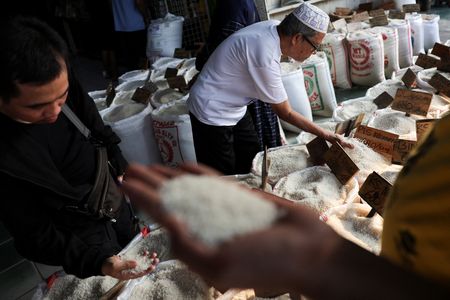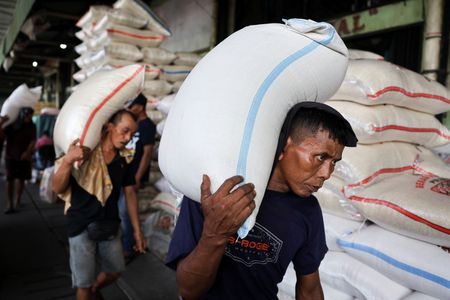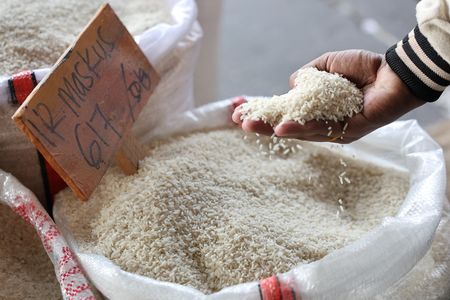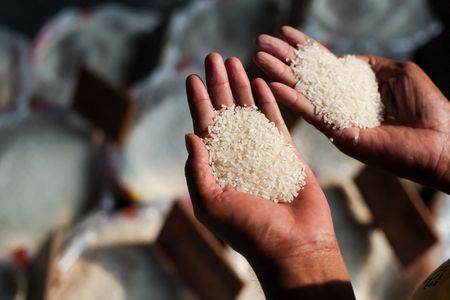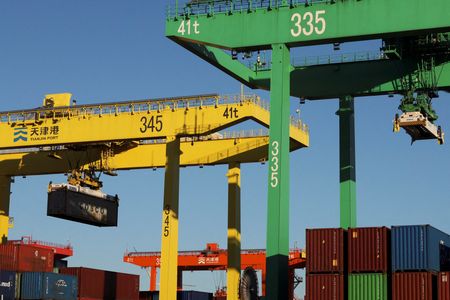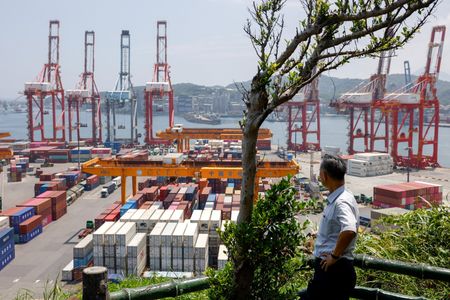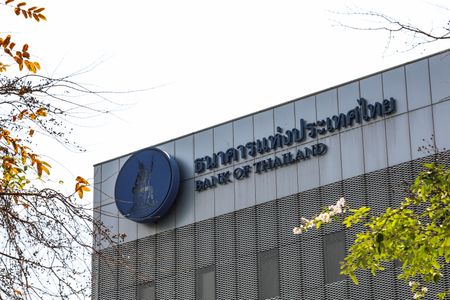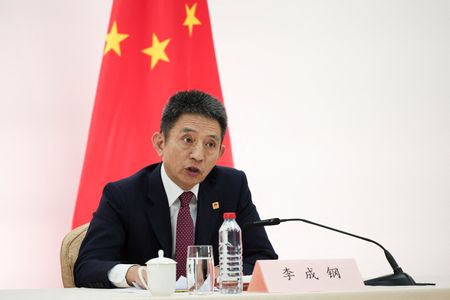By Dewi Kurniawati and Bernadette Christina
JAKARTA (Reuters) -Indonesian rice prices hit record highs recently despite a bumper harvest and vast stockpiles after the government raised its purchase price and lowered state-procurement quality standards, leading to a scramble for the grain and fueling consumer backlash.
The price of benchmark medium rice rose to 15,950 rupiah ($0.96) per kilogram in August, up nearly 5% since the start of the year and matching the record from March 2024, when the El Nino weather pattern led to drought and crimped domestic production.
While prices eased this month, they are still up more than 24% since early 2023.
The market scarcity of the grain that is a staple for most of Indonesia’s 280 million people has led to retailers imposing purchase limits, even though domestic output rose nearly 16% in the first seven months of the year.
The tightness stems from government efforts to bolster farm incomes and curb imports under President Prabowo Subianto, who took office last October and has sought greater self-sufficiency in food and energy.
In January, Jakarta raised its official purchase price for unhusked rice to 6,500 rupiah per kilogram from 6,000 rupiah and tasked state procurement firm Bulog with buying 3 million metric tons of domestic rice – nearly triple last year’s local buying.
In March, Prabowo ordered that the government purchase price should apply to “any quality” of rice – previously the price applied to rice with specific levels of water and broken grain. That led Bulog to buy lesser-quality rice, according to an industry official and an analyst.
The result, analysts say, is that Bulog ended up with vast quantities of poor-quality rice, forcing thousands of rice mills to scramble to secure unhusked grain by offering higher prices than Bulog.
Sutarto Alimoeso, chief of the Association of Rice Millers and Rice Entrepreneurs, said farmers took the opportunity to lock in the 6,500 rupiah price by rushing to harvest the grain before it was ripe.
As of September 8, Bulog’s stockpile stood at nearly 4 million metric tons, almost double end-2024 levels.
Bulog did not respond to a request for comment.
‘SUBOPTIMAL RICE MANAGEMENT’
The Indonesian Ombudsman, an independent body supervising public services, last month found that eight out of 35 Jakarta-area supermarkets surveyed had no rice at all and urged the government to immediately release reserves held by Bulog.
“The recent increase in rice prices is not due to stock shortages, but rather to suboptimal rice management,” it said.
Authorities have blamed high prices on milling companies, with police accusing 30 officials from several firms of violating consumer protection laws, including by mislabelling products to sell at higher prices.
To dampen prices, the government in July ordered Bulog to release 1.3 million metric tons by year-end, of which 210,791 tons were delivered to markets as of September 20, data showed.
The National Food Agency said that after food prices rose in July and August, the government intensified intervention measures and the rice price has started to ease.
But consumers have taken to social media to voice disappointment over limited availability of premium-quality rice in supermarkets.
Esther Sri Astuti, executive director of the Institute for Development of Economics and Finance, said rising food and other prices had contributed to recent protests across the country.
Indonesia’s statistics bureau expects rice output to rise more than 10% for the year to 33.52 million tons, exceeding forecast consumption of 31.2 million tons.
To be sure, Indonesia has succeeded this year in not importing rice after shipping in 4.52 million tons last year.
Global rice prices are lower this year, with Thai 5% broken rice down 21.5% through August.
($1 = 16,648.0000 rupiah)
(Reporting by Dewi Kurniawati and Bernadette Christina; Editing by Tony Munroe and Muralikumar Anantharaman)

